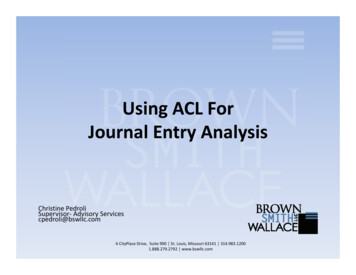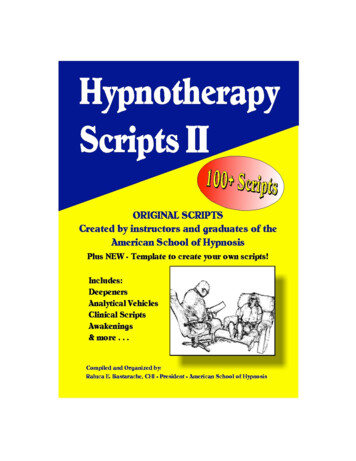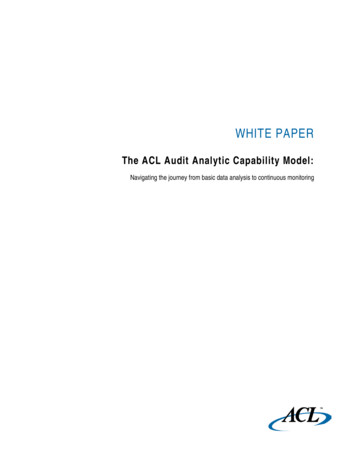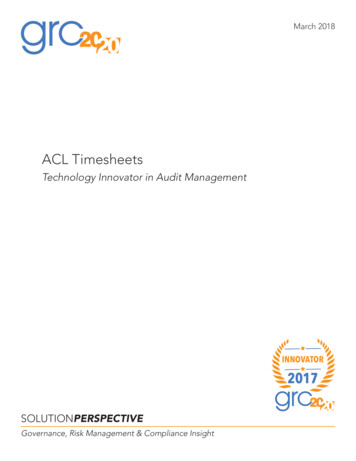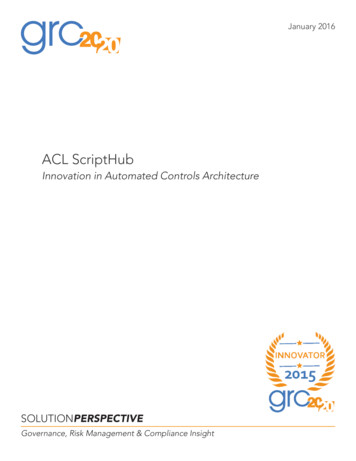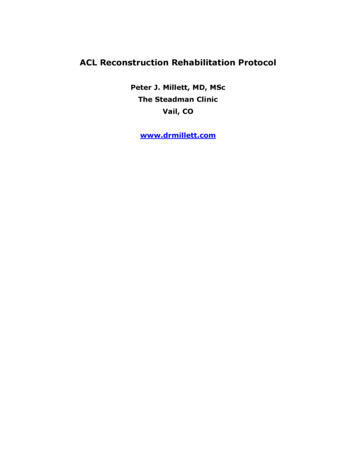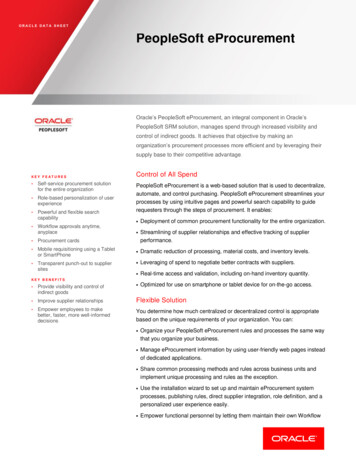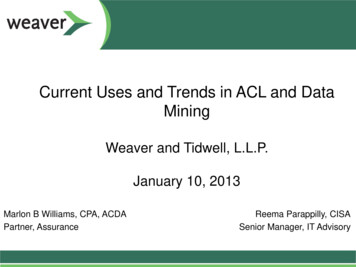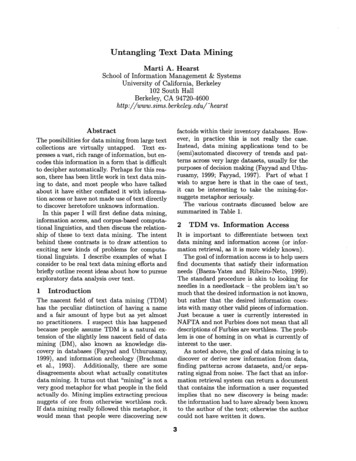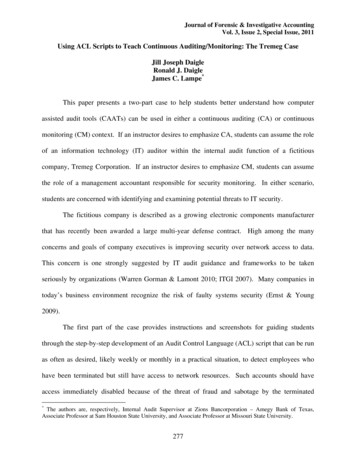
Transcription
Journal of Forensic & Investigative AccountingVol. 3, Issue 2, Special Issue, 2011Using ACL Scripts to Teach Continuous Auditing/Monitoring: The Tremeg CaseJill Joseph DaigleRonald J. DaigleJames C. Lampe*This paper presents a two-part case to help students better understand how computerassisted audit tools (CAATs) can be used in either a continuous auditing (CA) or continuousmonitoring (CM) context. If an instructor desires to emphasize CA, students can assume the roleof an information technology (IT) auditor within the internal audit function of a fictitiouscompany, Tremeg Corporation. If an instructor desires to emphasize CM, students can assumethe role of a management accountant responsible for security monitoring. In either scenario,students are concerned with identifying and examining potential threats to IT security.The fictitious company is described as a growing electronic components manufacturerthat has recently been awarded a large multi-year defense contract. High among the manyconcerns and goals of company executives is improving security over network access to data.This concern is one strongly suggested by IT audit guidance and frameworks to be takenseriously by organizations (Warren Gorman & Lamont 2010; ITGI 2007). Many companies intoday’s business environment recognize the risk of faulty systems security (Ernst & Young2009).The first part of the case provides instructions and screenshots for guiding studentsthrough the step-by-step development of an Audit Control Language (ACL) script that can be runas often as desired, likely weekly or monthly in a practical situation, to detect employees whohave been terminated but still have access to network resources. Such accounts should haveaccess immediately disabled because of the threat of fraud and sabotage by the terminated*The authors are, respectively, Internal Audit Supervisor at Zions Bancorporation – Amegy Bank of Texas,Associate Professor at Sam Houston State University, and Associate Professor at Missouri State University.277
Journal of Forensic & Investigative AccountingVol. 3, Issue 2, Special Issue, 2011employee or another individual obtaining password access. Automating the process by creatinga script that can be run on a repetitive and recurring basis for investigative follow-up on resultsgives students practical insights into CA/CM. The scenario in this case is one that is consistentwith IT audit guidance, which strongly suggests that systems security be monitored on anongoing basis (Warren Gorman & Lamont 2010).The second part of the case gives students more experience with ACL and CA/CMthrough the creation of another script for detecting active employees who have dormant networkaccounts. Such employees may have been terminated but did not have their access statuschanged to “inactive” by the human resources and/or IT functions. Some employees havingdormant accounts may still be active but should no longer have network access. In bothsituations, the accounts identified should have access immediately disabled because dormantaccounts can be an opportunity for fraud and data breaches. Part two can be used as a secondstep-by-step tutorial, or as an assignment or take-home exam without the detailed instructionsand screenshots. Treating part two as an assignment or take-home exam helps determine ifstudents are able to apply the knowledge and skills learned from part one. Students are alsorequired to respond in each part to ethical questions brought about by technology such as ACL,CA and CM and use critical thinking skills as professional auditors or accountants.This two-part case has been successfully used in multiple graduate IT issues and auditcourses at two universities with students having no prior knowledge or experience with ACL.Exit survey results collected show that students perceived that the case objectives were met.Students also provided enthusiastic anecdotal feedback. Besides IT audit courses, we believe thecase would also be useful in graduate AIS, audit and managerial accounting courses for exposingstudents to fraud investigation and CA/CM via the use of CAATs.278
Journal of Forensic & Investigative AccountingVol. 3, Issue 2, Special Issue, 2011We strongly believe that accounting curricula need to continue a trend toward holism.Courses intended to teach primarily financial, managerial, tax, audit or systems not only needcases that include state of the art technology and fresh techniques being adopted in audit andaccounting practice, but also cases that allow students to develop the ethical reasoning andcritical thinking required of auditing and accounting professionals. We believe the answer to thequestion of whether accounting ethics should be integrated into multiple existing technicalclasses in the curricula versus being taught exclusively in a stand alone course is YES. TheTremeg case allows students to exercise and expand skills in managerial control, auditing, fraudinvestigation, IT, written communication skills and ethics in one holistic case.We further believe that the scenario provided in the Tremeg case may be useful forbehavioral researchers interested in studying some particular aspect of CA/CM. The centralconcern control of system security is consistent with that highly expressed by businessprofessionals (Ernst & Young 2009), as well as specifically cited as an area deserving attentionwithin organizations (ITGI 2007), including on a continuous basis (Warren Gorman & Lamont2010). The need for behavioral research in CA and CM has been noted in the literature (forexample, Hunton et al. 2004). The scenario in the case, or one similar, could also be used todesign research experiments studying some particular aspect of CA/CM.The next section discusses the importance of teaching IT skills in controls monitoring andauditing, including the performance of CA and CM for detecting and investigating potentialfraud and errors. Later sections provide an overview of each part of the case, including examplescreenshots, discussion of how the second part of the case can be modified to be an assignmentor take-home exam, and student feedback to the two-part case. Appendices provide tutorials(solutions), an example modification of the second part as a take-home exam, and teaching notes.279
Journal of Forensic & Investigative AccountingVol. 3, Issue 2, Special Issue, 2011IMPORTANCE OF TEACHING IT AUDIT SKILLSWhether for a career in industry or public practice, all accounting student graduatesentering the workforce are required to have substantial IT literacy. From a financial statementaudit perspective, the issuance of Statement of Auditing Standard (SAS) #94 in 2001 recognizesthat financial statement auditors must consider the impact of IT on internal control when gainingan understanding, documenting and assessing internal control during audit planning.Thiscoupled with increasing IT complexity in business has created recognition and demand for ITaudit specialists, both external and internal to organizations. As demand continues to rise, morestudents desire the education and training to help them become IT audit specialists.The requirements for studying and transitioning to become a practicing Certified FraudExaminer (CFE) involve knowledge and experience in four areas: 1) fraud prevention anddeterrence; 2) financial transactions; 3) fraud investigation; and 4) legal elements of fraud.1 Therequirements for becoming a Certified Information Systems Auditor (CISA) are also verycomprehensive and include the need for knowledge and experience with CAATs.2 Knowledgeand experience in using CAATs for performing CA and CM are helpful to all accountingstudents, but essential for students working towards specialization in IT audit and fraudinvestigation in today’s business environment.IT knowledge, including its application toauditing and fraud investigation, is also important to management accountants.This isevidenced by the requirements for successfully becoming a Certified Management Accountant(CMA). The CMA exam specifically tests for in-depth IT knowledge and application (IMA2010):12Go to www.acfe.com and link into “Membership & Certification” then “Become a CFE” for further detail.Go to www.isaca.org and link into “Certification” for further detail.280
Journal of Forensic & Investigative AccountingVol. 3, Issue 2, Special Issue, 2011 The Financial Planning, Performance and Control section includes a subsection onInternal Controls, which covers risk assessment; internal control environment,procedures, and standards; responsibility and authority for internal auditing; types ofaudits; and assessing the adequacy of the accounting information system.Automated CAATs are being used in business as a means of repeatedly testing andreporting on subsets of data being processed by a complex IT system – i.e., CA and CM. CA isdefined as (AICPA/CICA 1999):“A methodology that enables independent auditors to provide assurance on asubject matter using a series of auditor reports issued virtually simultaneouslywith, or a short time period after, the occurrence of events underlying the subjectmatter.”A similar, yet different, activity to CA is CM.CM is a recurring and repetitivemanagement process for determining if particular activities of interest are in compliance withpolicies and procedures implemented by management (ISACA Standards Board 2002). Whileboth CA and CM incorporate similar techniques, CM is a management process (an internalcontrol activity) while CA is an independent audit process (either conducted by an internal orexternal auditor) (Daigle et al. 2008; Coderre 2005; ISACA Standards Board 2002).The automation of a CAAT allows auditors and accountants to very efficiently test 100%of new transactions or entries in subject matter areas of interest or particular controls, andexpress results as often as desired with little marginal cost incurred. Results of a 2006 survey ofinternal auditors report that 50% of the 392 respondents perform CA or CM within theircompanies, while another 31% plan to develop a CA or CM program (PwC 2006). Results of a2009 survey of 305 organizations by the Institute of Internal Auditors note that 32% ofrespondents perform CA within their organization (McCann 2009). These survey results show281
Journal of Forensic & Investigative AccountingVol. 3, Issue 2, Special Issue, 2011that CA and CM should be an important topic of coverage for those seeking a career as an IToriented auditor, fraud investigator or management accountant.One of the most commonly used CAATs is referred to as Generalized Audit Software(GAS). Two of the most commonly used GAS packages are ACL and IDEA. The Tremeg caseuses ACL. Due to the importance of the topics of IT auditing, CA and CM for detecting fraudand errors, ACL (or similar software such as IDEA) is receiving attention in several auditing andAIS textbooks. Many current textbooks are accompanied by ACL software and provide severalshort problems for students to solve using the software. ACL also produces an educationalversion with a site license that allows students to access a more extensive list of problems.At this time, it does not appear that any problems or short cases are available that providestudents with experience in using GAS (such as ACL) to perform CA/CM. The two-part casepresented here serves to compliment the problems found in current textbooks and the educationalversion of ACL as a means of providing students with insight to, and some practical experiencewith, using ACL to perform CA/CM for the purpose of identifying potential fraudulent threats ina fictitious setting. The case can be performed fully on most recent versions of ACL software(such as Versions 8 and 9, with minimal screenshot variations between the two versions),including the educational versions packaged with audit textbooks.3 The next two sections givean overview of each part of the case. The first part of the case is referred to as the “terminateduser” case while the second part is referred to as the “dormant account” case.OVERVIEW OF TERMINATED USER CASEThe terminated user case has five objectives:3An instructor teaching graduate IT auditing has used the basic structure and data of the two-part Tremeg case usingIDEA, and reports to us anecdotal evidence of successful use and adaptation.282
Journal of Forensic & Investigative AccountingVol. 3, Issue 2, Special Issue, 20111) Help understand the concept and application of CA/CM.2) Help learn how to perform basic ACL activities of:a) Importing data.b) Extracting data.c) Creating tables.d) Joining tables to create a new table.e) Filtering data in a table.f) Exporting data.3) Help learn how to automate basic ACL activities through the creation of scripts.4) Gain confidence in the future application of developing computer automation proceduresfor performing CA/CM after completing the first part of the case.5) Help better recognize potential ethical issues with an organization’s ability to analyzeemployee network activity.In the terminated user case, students act, at the discretion of the instructor, in either therole of either an IT auditor or a management accountant of a fictitious company, TremegCorporation, and complete six technical activities with associated deliverables. Students are firstguided through five ACL activities designed to identify terminated employees who may continueto have access to the company network. The sixth activity involves automating the first fiveactivities by developing an ACL script. The script can then be run repetitively, likely weekly ormonthly, for investigating whether any terminated users have access to the company network.The script provides an excellent example to students of performing CA/CM at a low marginalcost for testing controls and investigating threats of potential fraud and data breaches. Followingsuccessful completion of the technical aspects of using ACL, students are required to perform a283
Journal of Forensic & Investigative AccountingVol. 3, Issue 2, Special Issue, 2011seventh activity, which involves considering certain ethical ramifications regarding the analysisof employee network activity, and writing a response in the form of a memo.The task of identifying terminated users who continue to have access to networkresources is purposely selected because it is likely a key general control commonly identified byIT management, as well as internal and external auditors testing controls for both internaleffectiveness and efficiency and for financial statement audits. For publicly traded companies,the assessment of internal control over financial reporting is the direct responsibility of the CEOand CFO aided by management accountants and compliance officers who provide for the CEOand CFO assurance needed to sign the required report on internal controls.As evidence of the importance of preventing terminated users from having continuednetwork access, a survey of nearly 1,900 senior executives in more than 60 countries reports that75% of respondents are concerned with IT security threats and data breaches by formeremployees (Ernst & Young 2009). One conclusion drawn from the survey results is that CA/CMshould be implemented to reduce IT security threats and data breaches (Ernst & Young 2009).The overall concern for access security is reflected in numerous parts of COBIT 4.1 Framework(ITGI 2007).The Framework notes “access to programs and data” as one of the four IT general controlcategories. The Framework also notes “manage changes” and “ensure systems security” as twoof the twelve control objectives.The Framework further states that “job change andtermination” requires management to “ensure that appropriate and timely actions are takenregarding job changes and job terminations so that internal controls and security are notimpaired.” Emphasis is provided when further stating that “user account management” requiresmanagement to “establish procedures to ensure timely action relating to suspending and284
Journal of Forensic & Investigative AccountingVol. 3, Issue 2, Special Issue, 2011closing user accounts” (ITGI 2007). Other IT audit guidance also emphasizes the importance ofpreventing security breaches when specifying that “system access security logs” deserve“ongoing monitoring” (Warren Gorman & Lamont 2010).The use of CA/CM to identify control deficiencies, fraud, waste and abuse is referred toas “continuous control assessment” (Coderre 2005). IT security deficiencies could be judged bythe external auditor to be significant or even material to the likelihood of the financial statementscontaining misstatements. The terminated user case, therefore, gives students experience withtesting a very important general control that should exist and be tested in many currentorganizations, and to implement a type of test being suggested by practice.Step-by-step instructions and screenshots allow students to see the incremental value ofeach task, culminating in the automation of all activities for repetitive use. Each activity involvesa deliverable, typically a printed report that is straightforward to grade. Table 1 provides anoverview of the seven activities in the terminated user case. The complete set of instructions andscreenshots for the terminated user case is included in Appendix A. All Excel files referred tocan be obtained directly from the authors (Please see Table 1).Description of Terminated User Case ActivitiesThe first activity of the terminated user case involves using the Import command tocreate a table in ACL populated by the data from an Excel file of all Tremeg employees, whetheractive or terminated. This activity gives students experience with one of the most basic uses ofACL, importing data for subsequent testing and analysis.The second activity involves using the Extract command to populate a new table withdata of terminated employees from the table created in the first activity. This second activity285
Journal of Forensic & Investigative AccountingVol. 3, Issue 2, Special Issue, 2011builds upon the first by giving students experience with identifying criteria (terminatedemployees) for extracting specified records from the larger table of all employees. The resultingdistilled table is then available for further testing and analysis in later activities of the case.The third activity involves using the Import command to create a third table populated byall data from a second Excel file of active directory users at Tremeg. This activity is similar tothe first activity but using different data. Both the resulting table created in this activity and tableextracted in the second activity are subsequently used by students in the fourth activity todetermine which terminated users continue to have network access.The fourth activity involves using the Join command to create a fourth table of data foranalysis, which is based on data in the tables created in the second and third activities. A reportof the data in HTML format is also generated. This activity is the test that identifies thoseterminated users who continue to have network access, as well as the most recent time of access.Both are important to identify and investigate, but the second item more so because it indicatespotential misuse of network resources by terminated employees or some other individual (suchas a current employee) who has obtained access through the terminated employee’s account.Students are told in the tutorial that these terminated employees should be reported to the SystemAdministrator immediately so that access is disabled to prevent any further unauthorized accessand an examination be made of activity after the date of termination.The Join command is used to accomplish the two tasks of identifying terminatedemployees for whom network access has not yet been disabled and determining if unauthorizedaccess has occurred after the date of termination.The Join command matches employeenumbers from the active directo
One of the most commonly used CAATs is referred to as Generalized Audit Software (GAS). Two of the most commonly used GAS packages are ACL and IDEA. The Tremeg case uses ACL. Due to the importance of
